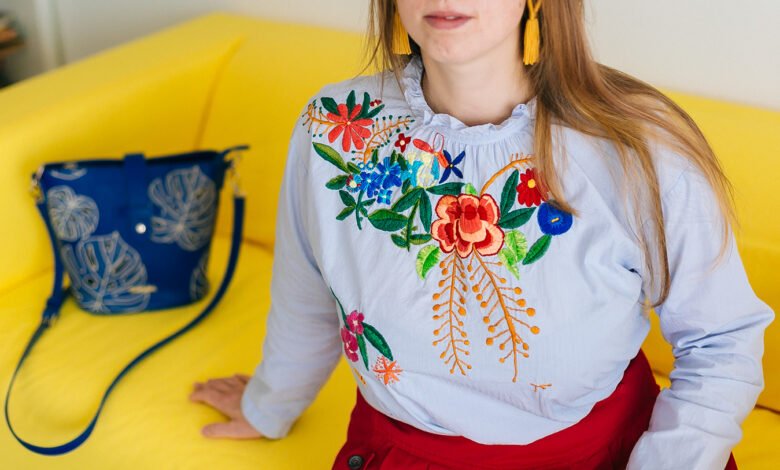
Embroidery is a timeless craft that can transform a plain shirt into a personalized and creative masterpiece. Custom embroidery on shirts has become increasingly popular, whether it’s for adding a personal touch to your wardrobe, making unique gifts, or even launching a small embroidery business from home. The best part? You can easily do custom embroidery on shirts right from the comfort of your home with a few basic tools, a bit of practice, and some creativity.
In this article, embroidery Dallas will walk you through the step-by-step process of how to do custom embroidery on shirts at home, including the materials you need, tips for choosing designs, and helpful techniques for beginners.
Materials You’ll Need for Custom Embroidery
Before you start embroidering, it’s important to gather all the necessary materials. Here’s a list of the essential items you’ll need:
- Shirt: Choose a shirt made of a fabric that is suitable for embroidery. Cotton, linen, and polyester are popular choices for beginners. Ensure the shirt is clean and free of wrinkles before starting.
- Embroidery Hoop: An embroidery hoop holds the fabric taut while you work, ensuring that your stitches are even and precise.
- Embroidery Needles: These needles are specially designed for hand embroidery and are sharper and thinner than regular sewing needles. Choose a size that suits the type of fabric you’re working with.
- Embroidery Floss: This is the thread used for embroidery. Embroidery floss is available in a wide variety of colors, allowing you to choose shades that complement your design.
- Fabric Stabilizer (Optional): If the fabric of the shirt is thin or stretchy, using a stabilizer can prevent puckering and help maintain the integrity of your design.
- Embroidery Scissors: Small, sharp scissors are ideal for cutting threads precisely without damaging the fabric.
- Tracing Paper or Transfer Pen: To transfer your design onto the fabric, you’ll need tracing paper, a transfer pen, or another method for outlining your design.
Choosing the Right Design for Your Shirt
Selecting a design is one of the most enjoyable parts of custom embroidery. Whether you’re creating something simple or complex, it’s important to choose a design that matches your skill level, the size of the shirt, and the fabric’s texture.
Beginners: Start with basic patterns such as initials, simple flowers, or geometric shapes. These designs are easier to manage and will help you get comfortable with different stitches.
Experienced Embroiderers: Once you’ve mastered the basics, you can explore more intricate designs, such as landscapes, portraits, or complex logos. You might also want to experiment with different types of embroidery stitches to add depth and texture to your work.
Preparing Your Shirt for Embroidery
Once you’ve selected your design, the next step is preparing your shirt for embroidery. Here’s how:
Step 1: Wash and Iron the Shirt
It’s important to wash and iron your shirt before you begin embroidering to ensure that it’s clean and smooth. This will help prevent the fabric from shrinking later, which could distort your embroidery work.
Step 2: Transfer the Design
There are several ways to transfer your design onto the shirt. You can use a water-soluble transfer pen, which will disappear after washing, or tracing paper to trace the design onto the fabric. If you’re using tracing paper, simply place it over your design, trace it, and then use the transfer method to imprint it onto your shirt.
Step 3: Place the Shirt in an Embroidery Hoop
Position the area of the shirt where you want to embroider in the center of your embroidery hoop. Tighten the hoop so that the fabric is pulled taut but not stretched too tightly, as this can distort your stitches.
Basic Embroidery Stitches for Shirts
If you’re new to embroidery, learning a few basic stitches is essential. These stitches are versatile and can be used to create a wide range of designs:
Backstitch
The backstitch is a simple stitch that creates a solid line of thread. It’s perfect for outlining shapes or adding detail to your design. To create a backstitch, pull the needle up through the fabric, make a stitch backward, and then bring the needle up again one stitch length ahead.
Running Stitch
The running stitch is one of the easiest stitches and is used for creating dashed lines. This stitch is made by moving the needle in and out of the fabric at even intervals.
Satin Stitch
The satin stitch is used for filling in areas of a design. To create this stitch, you make long, smooth stitches closely together, covering the fabric completely.
French Knot
The French knot adds texture and dimension to your design. To create this knot, wrap the thread around the needle a few times and then pull the needle through the fabric to create a small, raised knot.
Start Embroidering Your Shirt
With your shirt prepared and your design transferred, you’re ready to start embroidering! Here’s how to approach the process:
- Thread the Needle: Choose a color of embroidery floss that matches your design. Cut a length of thread (usually around 18 inches) and thread it through the embroidery needle. Tie a knot at the end of the thread to prevent it from slipping through the fabric.
- Begin with the Outline: Start with the outline of your design using a backstitch or running stitch. This will create the framework for the rest of your embroidery.
- Fill in the Design: After outlining, use stitches like satin stitch or French knots to fill in areas of the design with color and texture.
- Take Breaks: Embroidery is time-consuming, so it’s important to take regular breaks to prevent hand strain and ensure your work remains neat.
Finishing Touches
Once you’ve completed your embroidery, it’s time to finish your work:
- Remove the Hoop: Carefully remove the embroidery hoop from the shirt.
- Secure the Threads: Tie off the loose ends of the thread on the inside of the shirt and trim any excess threads with your embroidery scissors.
- Press the Shirt: Use a warm iron to press the shirt, being careful to place a cloth over the embroidered area to protect the stitches from damage.
Care Tips for Embroidered Shirts
To ensure your custom-embroidered shirts last, follow these care tips:
- Wash by Hand: Hand-washing is gentle on the stitches and helps prevent unraveling. Use mild detergent and cold water.
- Avoid High Heat: If using a washing machine, choose a delicate cycle with cold water, and avoid using a dryer. Let the shirt air dry.
- Iron Inside Out: When ironing, turn the shirt inside out and place a cloth over the embroidery to avoid direct contact with heat.
Conclusion
Custom embroidery on shirts is a rewarding and creative project that can be done right from home. With the right materials, some basic techniques, and a bit of practice, you can create beautifully embroidered shirts that showcase your personality and skills. Whether you’re personalizing your wardrobe, making thoughtful gifts, or experimenting with new designs, embroidery offers endless possibilities for creative expression.


